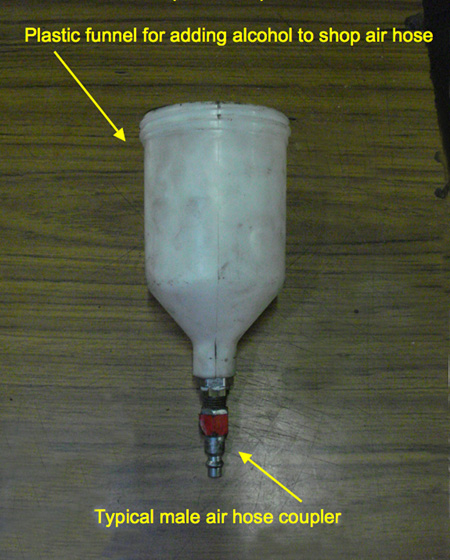

Safety and Maintenance
By Christopher W. Ferrone
I have written about winter preparation in the past [BUSRide, March 2009, Safety and Maintenance, Preparing for extreme cold operations]. But this year has been an especially cold winter in Chicago, which only exacerbated what was just a minor problem for our buses. Normally during the average winter we have about one airline a week freeze up on one of our buses. But as cold as it is this year I recently came across a solution specifically related to preventing the parking brake from freezing — a device anyone can make in the garage. Using this kit this winter we have completely eliminated air system and parking brake freeze-ups.
Basically, we inject alcohol into the air system to prevent any water or moisture trapped in the air tanks from freezing. But there is a problem with this. If alcohol injected into the system were to enter the air dryer, the dryer desiccant would react to the alcohol and become contaminated.
To prevent this from happening, I have put together a fitting assembly that connects to a common shop air hose and coupler that fills the shop air hose with alcohol. The assembly connects the shop air hoses to the wet air tank and the parking tank of the bus (see photo 1).
The first step in using this kit is to fill the shop air hose with six ounces of air brake anti-freeze (alcohol) using a fill funnel (see photo 2). The funnel can be a plastic, paint cup normally used for a gravity feed paint sprayer and a common male quick connect coupler.
Disconnect the shop air hose from the shop compressor to prevent the funnel from becoming pressurized. Then attach the funnel to the shop air hose and add the alcohol.
Next, wearing safety glasses during this process, completely drain both the wet air tank and the parking air tank. Connect the shop air hose to the wet air tank connector and fill the air tank with the air / alcohol mixture coming from the shop air hose. This step will inject alcohol into the wet air tank.

Add another six ounces of alcohol to the shop air hose using the funnel. Connect the shop air hose to the parking air tank connector. This will fill the tank with the air / alcohol mixture coming from the shop air hose.
Any technician can make this inexpensive kit from common air hose connectors and valves available at any parts store, as is the alcohol and funnel.
It is important to include an air shut-off valve between the quick connect coupler and the air tank. This will prevent any air leakage from the quick connect coupler if it fails to seal as a result of ice formation or debris inside this coupler.
As an additional step to prevent any unwanted accumulation of salt and debris, coat the outside surface of the quick connectors assembled and installed on the bus with a thin layer of grease.
As a final step, pull back the movable section of the female quick connector and apply never-seize compound with a brush. This will ensure the movable section of the connector will always move, allowing the connector to couple to the shop air hose male connector.
The total cost per bus comprised of two connector assemblies (wet and parking tank) is less than twenty dollars — a small price to pay for an almost guaranteed solution for the prevention of air system freeze-up.
Christopher W. Ferrone is president of Americoach Systems Inc., Glenview, IL, an engineering firm specializing in transportation, technology, analysis and safety.
